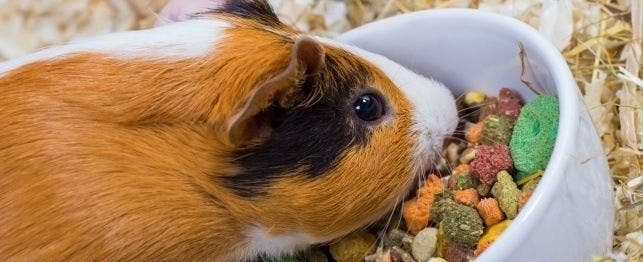
Feeding Your Guinea Pig
Guinea pigs are strict herbivores, or vegetarians, that don’t tolerate high carbohydrate or fatty diets. In the wild, they live on the hills and mountains of the Andes in Peru and graze all day, mostly on grasses and some foliage and other plant materials.
The nutritional needs of adult nonbreeding, nonlactating, and inactive pet guinea pigs have not been as well established as some of the other plant-eating small mammals. The nutritional requirements for guinea pigs used for breeding and scientific research is very different than the needs for our house pet guinea pig.
The recommended diet for pet guinea pigs consists of fresh guinea pig pellets (18 to 20 percent crude protein and 10 to 16 percent fiber), an unlimited supply of high quality grass hay (Timothy hay), fresh vegetables, plenty of vitamin C, and a steady supply of clean water.
Vitamin C
Guinea pigs MUST have vitamin C (ascorbic acid) added to their diet. Similar to humans, their body cannot make the vitamin and must rely on a vitamin C supplement. Although commercial guinea pig pellets contain extra vitamin C, it is active for only 90 days under the most ideal (dark, cool) storage conditions.
Realistically, the potency is most likely lost in five to six weeks from the date that is on the package. It is best to assume that not enough vitamin C is being supplied and to supplement adequate levels in the form of vegetables, fruit and putting vitamin C in the drinking water. Because vitamin C is light sensitive and loses 50 percent of its potency in 24 hours, you should cover the water bottle with a sock or foil. Also, change the water and add vitamin C daily.
Vegetables and fruits that have 20 mg of Vitamin C or more per ounce include: guava, orange and lemon with peel, parsley, Brussels sprouts, broccoli, collard, mustard greens and kale. Moreover, many guinea pigs like the taste of chewable vitamin C tablets and can be trained to eat them.
The optimum vitamin C required is 1 to 2 mg/100 grams of body weight daily. A male’s average adult weight is 900 to 1,200 grams and female’s is 700 to 900 grams. Because vitamin C is water soluble and the kidneys excrete excess amounts, overdosing is rarely a problem.
Grass Hay
One of the most important items in the guinea pig diet is grass hay, which should be fed in unlimited quantities to both adults and baby guinea pigs. It is important to provide an unlimited source of hay because pellets do not provide enough long fiber to keep their intestines in good working order. The long fibers stimulate muscle contraction of the intestines to improve and maintain gut motility to prevent gastrointestinal obstruction.
Chewing hay is also important. Like rabbits, the molars in guinea pigs are constantly growing and must be ground down by chewing. Constant chewing on hay promotes healthy and normal wear on their molars. Treats and chew sticks are not efficient at wearing the teeth.
Alfalfa hay is rich in protein and calcium, but when combined with pellets it doesn’t have the proper ratio of calcium and phosphorus. This can lead to improper gastrointestinal motility, such as diarrhea. It also may predispose certain guinea pigs to calcium oxalate bladder or kidney stones. Timothy hay is a better choice and is becoming more readily available. It’s important to keep your guinea pig sleek, so cut down on the amount of protein and calorie-rich pellets while feeding Timothy hay.
Pellets
It is important to feed pellets that are made specifically for guinea pigs. These pellets have vitamin C added to them, so buy fresh pellets and store them in a cool place.
Guinea pigs don’t tolerate high carbohydrate or fatty foods so don’t feed them “fiesta” or “gourmet” pellet mixtures that have seeds, nuts or dried fruits. Because pellets tend to be higher in protein and calories, you need to restrict the amount you give him once he is an adult to prevent obesity.
Vegetables
Fresh vegetables – kale, escarole, endive, spring mixes, carrot tops, parsley, cilantro and spinach – can help maintain a healthy intestinal tract, while providing plenty of vitamins and minerals. When you start to add vegetables to your pet’s diet, offer only one type at a time, so if there are digestive upsets you’ll know what’s causing them.
Fortify the Water
Make sure your pet has plenty of fresh, clean water fortified with vitamin C. Water should be changed daily, and containers cleaned to prevent build-up of algae and bacteria.
Offer New Foods Gradually
Generally, guinea pigs are afraid of new things and any diet changes should be made slowly. They have a specialized digestive tract comparable to that of a rabbit or a horse, which enables them to extract nutrients from plant material. There is a diverticulum (like our appendix except proportionately larger) called the cecum, which stores and mixes the ingested material providing a perfect environment for bacteria to ferment and break down plant fibers. Periodically, the cecum is emptied and the intestinal tract then absorbs the essential nutrients.
Changes to the bacteria can hinder the ability to digest their food and cause harmful bacteria (like Clostridium) to overgrow and cause illness. This is why giving antibiotics and changing the diet should be done with caution.